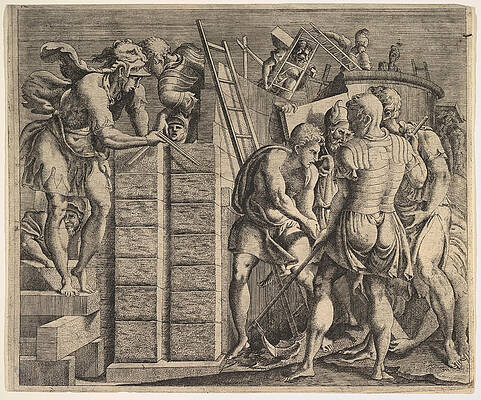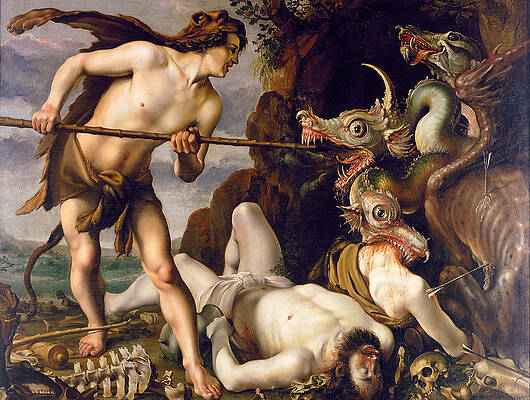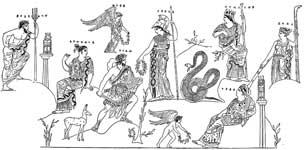
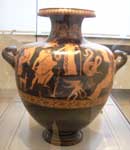
Kadmos or Cadmus (Greek: Κάδμος), in Greek mythology, was the son of the king of Phoenicia and brother of Europa.
His father is either Agenor or Phoenix son of Agenor. See Agenor and Phoenix.
After his sister had been carried off by Zeus, he was sent out to find her. Unsuccessful in his search, he came in the course of his wanderings to Delphi, where he consulted the oracle. He was ordered to give up his quest and follow a cow which would meet him, and to build a town on the spot where she should lie down exhausted.

Cadmus Sowing the Dragon's teeth, by Maxfield Parrish, 1908
The cow was given to Cadmus by Pelagon, King of Phocis, and it guided him to Boeotia, where he founded the city of Thebes. Robert Graves (The Greek Myths) suggested that the cow was actually turned loose within a moderately confined space, and that where she lay down, a temple to the moon-goddess (Selene) was erected: "A cow's strategic and commercial sensibilities are not well developed," Graves remarked.
Intending to sacrifice the cow to Athena, Cadmus sent some of his companions to the nearby Castalian Spring, for water. They were slain by the spring's guardian water-dragon (compare the Lernaean Hydra), which was in turn destroyed by Cadmus, the duty of a culture hero of the new order.
By the instructions of Athena he sowed its teeth in the ground, from which there sprang a race of fierce armed men, called Spartes ("sown"). By throwing a stone among them Cadmus caused them to fall upon each other till only five survived, who assisted him to build the Cadmeia or citadel of Thebes and became the founders of the noblest families of that city.
Cadmus, however, because the dragon was sacred to Ares, had to do penance for eight years by serving that god. At the expiration of this period the gods gave him as wife Harmonia, daughter of Ares and Aphrodite, by whom he had a son Polydorus, and four daughters, Ino, Autonoe, Agave and Semele.
At the wedding all the gods were present; Harmonia received as bridal gifts a peplos worked by Athena and a necklace made by Hephaestus. Notwithstanding the divinely ordained nature of his marriage and his kingdom, Cadmus lived to regret both: his family was overtaken by grievous misfortunes and his city by civil unrest. Cadmus finally abdicated in favor of his son, and retired with Harmonia to Illyria, whose inhabitants proclaimed him their king.

Cadmus and Harmonia, Evelyn De Morgan 1877
Nevertheless, Cadmus was deeply troubled by the ill-fortune which clung to him as a result of his having killed the sacred dragon, and one day remarked that if the gods were so enamored of the life of a serpent he might as well wish that life for himself. Immediately he began to grow scales and change in form. Harmonia, seeing the transformation, immediately begged the gods to share her husband's fate, and she did.
In another variation of the story, the bodies of Cadmus and his wife were changed after their deaths; the serpents watched their tomb while their souls were translated to the Elysian fields.
As if to convince any that doubt whether myth has kept its power, modern Greeks contend that there is little doubt that Cadmus was originally a Boeotian, that is, a Greek hero. In later times the story of a Phoenician immigrant of that name became current, to whom was ascribed the introduction of the alphabet, the invention of agriculture and working in bronze and of civilization generally. But the name itself is Greek rather than Phoenician; and the fact that Hermes was worshipped in Samothrace under the name of Cadmus or Cadmilus seems to show that the Theban Cadmus was originally an ancestral Theban hero corresponding to the Samothracian. The name may mean "order," and be used to characterize one who introduces order and civilization.
In Hebrew, the root kdm signifies "the east," the Levantine origin of "Kdm" himself, according to all the Greek mythographers.
Image
Cadmus and the serpent. South Italian red-figure vase ca. 340 BC. Musée du Louvre, Paris.
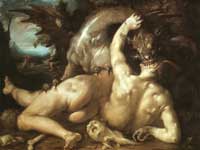
Two Followers of Cadmus devoured by a Dragon
Cadmus Founding Thebes, Master of the Story of Cadmus
Cadmus slays the dragon, Hendrik Goltzius
Cadmus Sowing Dragon's Teeth, Workshop of Peter Paul Rubens
Cadmus and Minerva, Jacob Jordaens

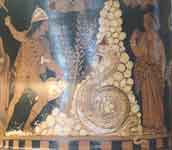
Apollodorus. Bibliotheke III, i, 1-v, 4; Ovid. Metamorphoses III,1-137; IV, 563-603.
The Greek Myths: The Complete And Definitive Edition, Robert Graves
See also : Greek Mythology. Paintings, Drawings
Greek Mythology Index
A - B - C - D - E - F - G - H - I - J - K - L - M -
N - O - P - Q - R - S - T - U - V - W - X - Y - Z
Α - Β - Γ - Δ - Ε - Ζ - Η - Θ - Ι - Κ - Λ - Μ -
Ν - Ξ - Ο - Π - Ρ - Σ - Τ - Υ - Φ - Χ - Ψ - Ω
Retrieved from "http://en.wikipedia.org/"
All text is available under the terms of the GNU Free Documentation License
| Ancient Greece
Science, Technology , Medicine , Warfare, , Biographies , Life , Cities/Places/Maps , Arts , Literature , Philosophy ,Olympics, Mythology , History , Images Medieval Greece / Byzantine Empire Science, Technology, Arts, , Warfare , Literature, Biographies, Icons, History Modern Greece Cities, Islands, Regions, Fauna/Flora ,Biographies , History , Warfare, Science/Technology, Literature, Music , Arts , Film/Actors , Sport , Fashion --- |

